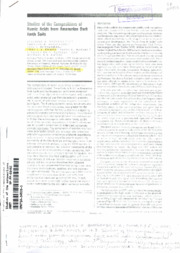Studies of the compositions of humic acids from Amazonian Dark Earth soils.
Studies of the compositions of humic acids from Amazonian Dark Earth soils.
Author(s): NOVOTNY, E. H.; AZEVEDO, E. R. de; BONAGAMBA, T. J.; CUNHA, T. J. F.; MADARI, B. E.; BENITES, V. de M.; HAYES, M. H. B.
Summary: The compositions of humic acids (HAs) isolated from cultivated and forested "Terra Preta de Índio" or Amazonian Dark Earth soils (anthropogenic soils) were compared with those from adjacent non-anthropogenic soils (control soils) using elemental and thermogravimetric analysis, and a variety of solid-state nuclear magnetic resonance techniques. The thermogravimetric index, which indicates the molecular thermal resistance, was greater for the anthropogenic soils than for the control soils suggesting palycyclic components in the former. The cultivated anthropogenic soils were more enriched in C and depleted in H than the anthropogenic soils under forest, as the result of the selective degradation of aliphatic structures and the possible enrichment of H-deficient condensed aromatic structures. The combination of variable amplitude cross-polarization (VACP) and chemical shift anisotropy with total suppression of spinning sidebands experiments with composite pulses could be used to quantify the aromaticity of the HAs from the anthropogenic soils. From principal component analysis, using the VACP spectra, it was possible to separate the different constituents of the HAs, such as the carboxylated aromatic structures, from the anthropognic soils and plant derived compounds. The data show that the HAs from anthropogenic soils have high contents of aryl and ionisable oxygenated functional groups, and the major functionalities from adjacent control soils are oxygenated functional groups from labile structures (carbohydrates, peptides, and with evidence for lignin structures). The anthropogenic soils HAs can be considered to be more recalcitrant, and with more stable reactive functional groups which may, in part, explain their more sustainable fertility due to the organic matter contribution to the soil cation exchange capacity.
Publication year: 2007
Types of publication: Journal article
Unit: Embrapa Semi-arid Region
Keywords: Amazonia, Composição, Soil, Solo, Solo Florestal, Solo Ácido, Terra Preta de Índio, Ácido húmico
Observation
Some of Embrapa's publications are published as ePub files. To read them, use or download one of the following free software options to your computer or mobile device. Android: Google Play Books; IOS: iBooks; Windows and Linux: Calibre.
Access other publications
Access the Agricultural Research Database (BDPA) to consult Embrapa's full library collection and records.
Visit Embrapa Bookstore to purchase books and other publications sold by Embrapa.

